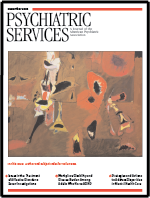Racial Differences in Syndromal and Subsyndromal Depression in an Older Urban Population
Abstract
OBJECTIVE: The authors explored racial differences in the prevalence of depression and its associated factors among older persons. METHODS: Using 1990 census data for Brooklyn, New York, the authors attempted to interview all cognitively intact persons age 55 years and older in randomly selected block groups. The sample was weighted by ethnicity and gender. The authors adapted George's Social Antecedent Model of Depression to allow examination of 20 independent variables and the nominal dependent variable consisting of three levels of depression. The data were analyzed with SUDAAN. RESULTS: Syndromal depression was found among 8 percent of blacks and 10 percent of whites. Subsyndromal depression was found among 13 percent of blacks and 28 percent of whites. No racial differences were found in rates of syndromal depression, but significant racial differences were found in rates of subsyndromal depression and of any type of depression. Nonlinear effects on both types of depression were found, and higher levels of stress had a greater impact on whites than on blacks. The racial difference in subsyndromal depression was explained by its lower prevalence among French-speaking African Caribbeans. Many racial differences were found in the variables associated with syndromal and subsyndromal depression. CONCLUSIONS: Race had an independent effect on the rate of subsyndromal depression and an interactive effect with stress on the rate of both syndromal and subsyndromal depression. For each racial group, different elements may play a role in the etiology, maintenance, and relief of depression. The findings underscore the importance of recognizing within-group and between-group racial differences in depression.



